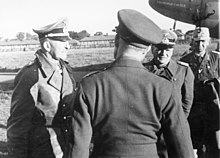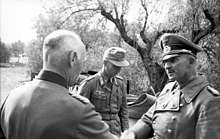Hans-Jürgen von Arnim
Hans-Jürgen Theodor von Arnim (born April 4, 1889 in Ernsdorf ; † September 1, 1962 in Bad Wildungen ) was a German army officer (from 1942 Colonel General ) and during the Second World War he was a division , corps and army commander .
Life
family
He came from an old Brandenburg aristocratic family who lived in castles in the Uckermark in the 16th century . His parents were the Prussian major general Hans von Arnim (1861–1931) and his wife Martha, née Honrichs (1865–1953).
Arnim married Annemarie von Dechend (1895–1982) in Berlin on March 26, 1917 , the daughter of the Prussian lieutenant colonel Max von Dechend and Marianne Koch.
Empire and First World War
Arnim came early April 1908 as an ensign in the 4th Guards Regiment walk the Prussian army and was promoted after attending the military academy in Gdansk on 19 August 1909 with patent of 17 August 1907, Lieutenant . As such, he was adjutant of the 1st Battalion from October 1913 . With the outbreak of World War Arnim came in the same capacity in the Reserve Infantry Regiment. 93, and in accordance mobilization plan from parts of his previous association was formed and prepared for the new 1st Guards Reserve Division entered. He was wounded during the conquest of Namur and returned to his regiment, which had meanwhile been transferred to the Eastern Front , after a stay in a hospital in mid-September 1914 . Here Arnim was temporarily deputy regimental adjutant and, after his promotion to first lieutenant, company commander. After the regiment (it belonged to the 4th Guards Infantry Division since May 1915 ) was relocated to the Western Front in October 1915 , Arnim was wounded again during the trench warfare in Flanders in July 1916. Three months later he returned to the regiment after his stay in the hospital and was assigned to the staff of the 4th Guard Infantry Division as an orderly officer . At the beginning of January 1917 he was transferred to the divisional staff in this capacity and on January 27, 1917 he was promoted to captain . For two and a half months he worked as an auxiliary officer at the General Command of the Guard Reserve Corps until Arnim was appointed adjutant of the 4th Guard Infantry Division on July 4, 1917. At the same time, until the end of the war, he was commanded several times as a battalion leader for Reserve Infantry Regiment No. 93.
Awarded both classes of the Iron Cross , the Knight's Cross of the Royal House Order of Hohenzollern with Swords, the Hamburg Hanseatic Cross and the Silver Wound Badge , Arnim was accepted into the Provisional Reichswehr as a company commander in the Reichswehr Infantry Regiment 29 after the end of the war and demobilization .
Weimar Republic and first years in the "Third Reich"
On 1 October 1920 he became a company commander in the Infantry Regiment 5 in Angermünde appointed and received from 1 October 1921, one-year leader assistant training the staff of the 2nd Division . Arnim then moved to the staff of Group Command 2 in Kassel and on October 1, 1924, to the troops office of the Reichswehr Ministry in Berlin. After moving to the staff of Group Command 1 on October 1, 1925, he came to the staff of the 7th Division in Munich on December 1, 1926 , where he was promoted to major on April 1, 1928 . At the same time he was assigned to the 7th (Bavarian) Motor Vehicle Department for training.
On October 1, 1929, he moved to the staff of Artillery Leader VII, was promoted to Lieutenant Colonel on April 1, 1932 and was appointed commander of the 1st Battalion in the 2nd Infantry Regiment on October 1, 1932 . From there Arnim changed on March 15, 1934 as first general staff officer (Ia) in the staff of Artillery Leader VI, which was also known as the "Bremen" division, where he was promoted to colonel on July 1, 1934 . On January 1, 1938, he was promoted to major general.
Second World War
On September 8, 1939, he was appointed commander of the 52nd Infantry Division . On December 1, 1939, he was promoted to lieutenant general . With his division he took part in the western campaign in 1940 . From October 5, 1940, Arnim was in command of the 27th Infantry Division , which was reclassified to the 17th Panzer Division a little later .
Shortly after the attack on the Soviet Union began , in which his division was used as part of Panzer Group 2 of Army Group Center , Arnim was wounded on June 28, 1941 near Stolpce in Belarus, which was followed by a long hospital stay in Germany. After receiving the Knight's Cross of the Iron Cross on September 4th , he took over command of the division again from mid-September. During the following double battle near Vyazma and Bryansk , the association succeeded in conquering Bryansk in October , followed by an advance on Tula . The 17th Panzer Division under Arnim's leadership was the only division of the Wehrmacht in which the notorious commissar order was demonstrably not carried out.

On November 11, 1941, Arnim took over the command of XXXIX deployed at Tichwin as part of Army Group North . Army Corps (motorized) (renamed XXXIX. Panzer Corps in 1942 ). Under heavy Soviet attacks during the battle for Tikhvin , his corps had to withdraw to Volkhov in December . On December 17, Arnim was promoted to General of the Panzer Force . In May 1942, after several unsuccessful attempts, his corps succeeded in relieving the Cholm pocket . This was followed by the subordination of the corps to the 9th Army , which was involved in heavy defensive battles in the context of the Battle of Rzhev . On December 13, 1942, he was judged by the Commander in Chief of the 9th Army, Colonel General Walter Model :
“In defensive battles, fully proven commanding general. Energetic and responsible. Was unconditionally committed and showed an unshakable, confident attitude even in crisis situations. Lives and leads in the sense of the National Socialist worldview. "
With promotion to Colonel General on 3 December 1942, he was appointed commander in chief in Tunisia laid down 5th Panzer Army appointed. With this he achieved several defensive successes during the battle for Tunisia . After Erwin Rommel was recalled , he succeeded him on March 9, 1943 as Commander in Chief of Army Group Africa . On May 13, 1943 he went with the staff of Army Group Africa near Tunis into British captivity .
Captivity

After Field Marshal Friedrich Paulus , Hans-Jürgen von Arnim was the highest-ranking German soldier in Allied custody until the end of the war. From May 16, 1943 to June 16, 1944 he was first camp senior in the English general camp Trent Park . However, he did not succeed in ending the smoldering dispute between the Nazi opponents around Wilhelm Ritter von Thoma and the Hitlerite officers around Ludwig Crüwell , because he "did not have the necessary charisma to arbitrate between the different opinions". Rather, he waved "back and forth between the two groups in the camp without clearly taking sides" - possibly because he believed that because of his position he had to defend the Nazi regime externally without being internally convinced of it. In 1944 Arnim was transferred with a group of other generals to the United States at Clinton General Camp, Mississippi. There, too, his behavior as camp leader remained ambivalent: on the one hand, he left Major General Botho Henning Elster , who was attacked by officers loyal to the Nazis and who was later sentenced to death in absentia by a Nazi court martial, from all because of his surrender to the Allied troops Acquitting suspicions of defeatism and cowardice, on the other hand he criticized Elster in writing for his refusal to give the “ German greeting ” and his publicly expressed doubts about the “ final victory ”. On July 1, 1947, Arnim was released from captivity and repatriated to Germany.
literature
- Dermot Bradley , Karl-Friedrich Hildebrand, Markus Rövekamp: The Generals of the Army 1921-1945. The military careers of the generals, as well as the doctors, veterinarians, intendants, judges and ministerial officials in the general rank. Volume 1: Abberger – Bitthorn. Biblio Verlag, Osnabrück 1993, ISBN 3-7648-2423-9 , pp. 97-99.
- Genealogical manual of the nobility . Noble houses A. Volume VIII, p. 99, Volume 38 of the complete series, CA Starke Verlag, Limburg (Lahn) 1966, ISSN 0435-2408
- Sönke Neitzel: bugged. German generals in British captivity 1942–1945. ISBN 3-549-07261-9 .
- Derek R. Mallett: Hitler's Generals in America: Nazi POWs and Allied Military Intelligence. University Press of Kentucky, 2013, ISBN 978-0-8131-4251-7 .
Web links
Individual evidence
- ^ Jürgen Kraus : Handbook of the units and troops of the German army 1914-1918. Part VI: Infantry. Volume 2: Reserve and Landwehr Regiments. Verlag Militaria, Vienna 2012, ISBN 978-3-902526-52-6 , p. 109.
- ^ Extract from the German lists of losses (Preuss. 20), p. 87
- ^ Extract from the German lists of losses (Preuss. 607) of August 15, 1916, p. 14063
- ↑ Reichswehr Ministry (Ed.): Ranking list of the German Reichsheeres. Mittler & Sohn Verlag, Berlin 1930, p. 124.
- ↑ Veit Scherzer : Knight's Cross bearers 1939-1945. The holders of the Iron Cross of the Army, Air Force, Navy, Waffen-SS, Volkssturm and armed forces allied with Germany according to the documents of the Federal Archives. 2nd Edition. Scherzers Militaer-Verlag, Ranis / Jena 2007, ISBN 978-3-938845-17-2 , p. 194.
- ↑ Christian Streit: No Comrades: The Wehrmacht and the Soviet Prisoners of War 1941–1945. DVA, Stuttgart 1978, p. 84.
- ^ Sönke Neitzel: bugged. German generals in British captivity 1942–1945. Propylaea, Berlin 2005, ISBN 978-3-549-07261-5 , pp. 39, 429.
- ^ Welf Botho Elster: The limits of obedience. The life of Major General Botho Henning Elster in letters and contemporary testimonies. Verlag Olms, Hildesheim 2005, ISBN 3-487-08457-0 , pp. 138-140.
| personal data | |
|---|---|
| SURNAME | Arnim, Hans-Jürgen von |
| ALTERNATIVE NAMES | Arnim, Hans-Jürgen Theodor von (full name) |
| BRIEF DESCRIPTION | German officer and colonel general in World War II |
| DATE OF BIRTH | April 4, 1889 |
| PLACE OF BIRTH | Ernsdorf |
| DATE OF DEATH | September 1, 1962 |
| Place of death | Bad Wildungen |

